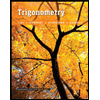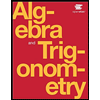SI A Qadrant II, what 4. %3D GIven that tan (t) = and is in
Trigonometry (11th Edition)
11th Edition
ISBN:9780134217437
Author:Margaret L. Lial, John Hornsby, David I. Schneider, Callie Daniels
Publisher:Margaret L. Lial, John Hornsby, David I. Schneider, Callie Daniels
Chapter1: Trigonometric Functions
Section: Chapter Questions
Problem 1RE:
1. Give the measures of the complement and the supplement of an angle measuring 35°.
Related questions
Topic Video
Question
100%
Hi I need help solving this problem
![**Trigonometric Problem:**
Given that \(\tan(\theta) = \frac{3}{4}\) and \(\theta\) is in Quadrant III, what is \(\cos(\theta)\)?
**Explanation:**
In trigonometry, the tangent function tan(θ) is a ratio of the opposite side to the adjacent side in a right triangle. The problem indicates that θ is in Quadrant III, where both sine and cosine are negative.
To find \(\cos(\theta)\), use the Pythagorean identity:
\[ \tan(\theta) = \frac{\sin(\theta)}{\cos(\theta)} \]
Given \( \tan(\theta) = \frac{3}{4} \), we set up a right triangle where:
- Opposite side \(= 3k\)
- Adjacent side \(= 4k\)
Using the Pythagorean theorem:
\[ (3k)^2 + (4k)^2 = h^2 \]
\[ 9k^2 + 16k^2 = h^2 \]
\[ 25k^2 = h^2 \]
\[ h = 5k \]
In Quadrant III, \(\cos(\theta)\) is negative, so:
\[ \cos(\theta) = \frac{-4k}{5k} = -\frac{4}{5} \]
Thus, \(\cos(\theta) = -\frac{4}{5}\).](/v2/_next/image?url=https%3A%2F%2Fcontent.bartleby.com%2Fqna-images%2Fquestion%2F5fe22a46-7618-4b05-a024-d92b45c5cc20%2Fd389c750-d40d-451c-88e1-cafb3c67148d%2F2849ral.jpeg&w=3840&q=75)
Transcribed Image Text:**Trigonometric Problem:**
Given that \(\tan(\theta) = \frac{3}{4}\) and \(\theta\) is in Quadrant III, what is \(\cos(\theta)\)?
**Explanation:**
In trigonometry, the tangent function tan(θ) is a ratio of the opposite side to the adjacent side in a right triangle. The problem indicates that θ is in Quadrant III, where both sine and cosine are negative.
To find \(\cos(\theta)\), use the Pythagorean identity:
\[ \tan(\theta) = \frac{\sin(\theta)}{\cos(\theta)} \]
Given \( \tan(\theta) = \frac{3}{4} \), we set up a right triangle where:
- Opposite side \(= 3k\)
- Adjacent side \(= 4k\)
Using the Pythagorean theorem:
\[ (3k)^2 + (4k)^2 = h^2 \]
\[ 9k^2 + 16k^2 = h^2 \]
\[ 25k^2 = h^2 \]
\[ h = 5k \]
In Quadrant III, \(\cos(\theta)\) is negative, so:
\[ \cos(\theta) = \frac{-4k}{5k} = -\frac{4}{5} \]
Thus, \(\cos(\theta) = -\frac{4}{5}\).
Expert Solution
This question has been solved!
Explore an expertly crafted, step-by-step solution for a thorough understanding of key concepts.
This is a popular solution!
Trending now
This is a popular solution!
Step by step
Solved in 3 steps

Knowledge Booster
Learn more about
Need a deep-dive on the concept behind this application? Look no further. Learn more about this topic, trigonometry and related others by exploring similar questions and additional content below.Recommended textbooks for you

Trigonometry (11th Edition)
Trigonometry
ISBN:
9780134217437
Author:
Margaret L. Lial, John Hornsby, David I. Schneider, Callie Daniels
Publisher:
PEARSON

Trigonometry (MindTap Course List)
Trigonometry
ISBN:
9781305652224
Author:
Charles P. McKeague, Mark D. Turner
Publisher:
Cengage Learning


Trigonometry (11th Edition)
Trigonometry
ISBN:
9780134217437
Author:
Margaret L. Lial, John Hornsby, David I. Schneider, Callie Daniels
Publisher:
PEARSON

Trigonometry (MindTap Course List)
Trigonometry
ISBN:
9781305652224
Author:
Charles P. McKeague, Mark D. Turner
Publisher:
Cengage Learning


Trigonometry (MindTap Course List)
Trigonometry
ISBN:
9781337278461
Author:
Ron Larson
Publisher:
Cengage Learning